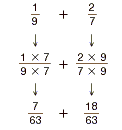Adding Fractions with Unlike Denominators
Finding equivalent fractions with like denominators can be
accomplished by multiplying both the numerator and denominator of
each fraction by the denominator of the other fraction
Example 1
Find  . .
Solution
Multiply both the numerator and denominator of  by 7 ( the denominator
of by 7 ( the denominator
of  ) . ) .

Multiply both the numerator and denominator of  by 3 ( the denominator
of by 3 ( the denominator
of  ) . ) .

Now replace each original fraction with its equivalent
fraction and add.

The fraction  is an improper
fraction, which is a fraction whose numerator is greater
than its denominator. Since 21 goes into 23 once with a remainder
of 2, the sum can also be written as a mixed number. So, is an improper
fraction, which is a fraction whose numerator is greater
than its denominator. Since 21 goes into 23 once with a remainder
of 2, the sum can also be written as a mixed number. So,

Here is an algorithm for adding fractions with unlike
denominators.
Algorithm for Adding Fractions with Unlike
Denominators
1. Multiply both the numerator and denominator of each
fraction by the denominator of the other fraction. The resulting
equivalent fractions will have the same denominator.

2. Add the equivalent fractions by adding their numerators and
retaining the like denominator.

Example 2
Find  . .
Solution
Step 1 Multiply both the numerator and
denominator of  by 11, and multiply
both the numerator and denominator of by 11, and multiply
both the numerator and denominator of  by 9. by 9.

Step 2 Add the equivalent fractions.

|